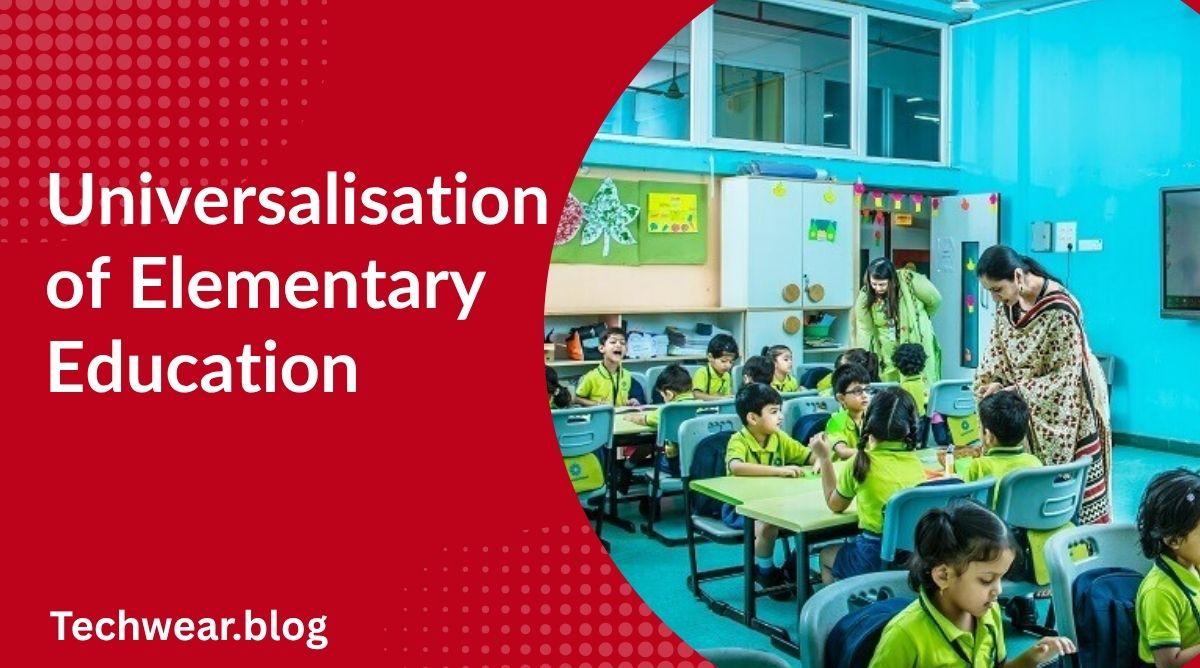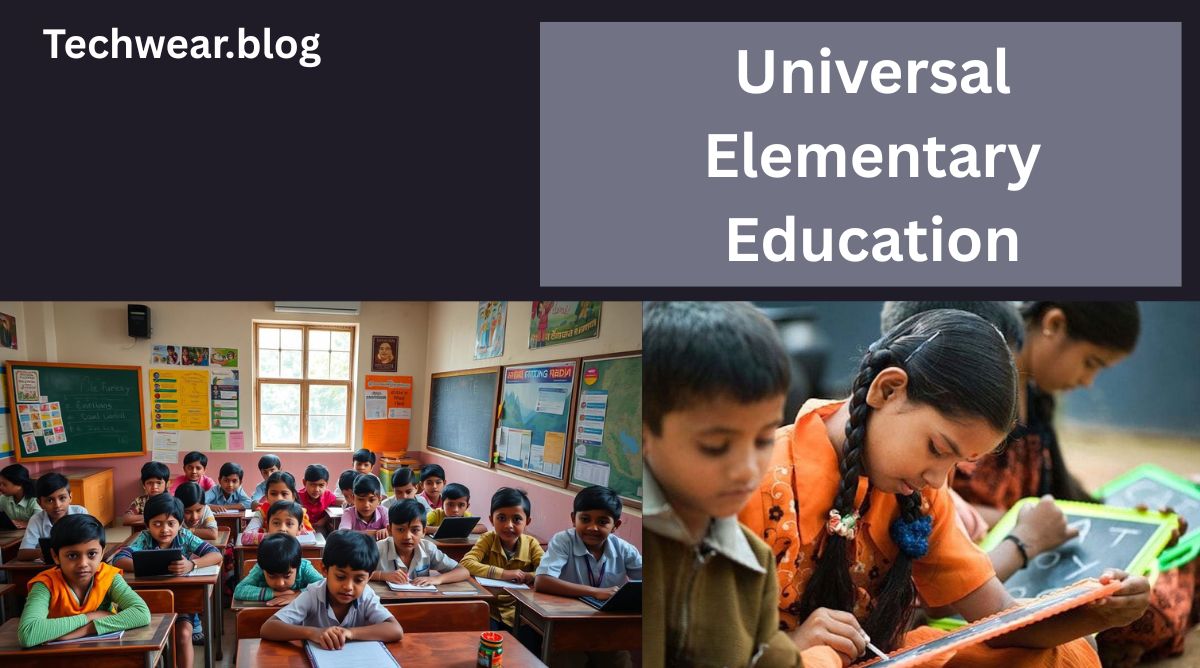The universalisation of elementary education is a critical goal for nations seeking to ensure that every child has access to quality education, regardless of their socio-economic background, gender, ethnicity, or geographical location. This concept represents the commitment of governments, educators, and international organisations to make elementary education available, affordable, and compulsory for all children. In countries like India, this vision has been enshrined in policy frameworks, constitutional provisions, and international agreements, making it a top developmental priority. According to Wikipedia, this initiative is part of the larger effort to eliminate illiteracy, reduce social inequalities, and create an empowered and informed citizenry.
Meaning of Universalisation of Elementary Education
Universalisation of elementary education refers to the process of providing free, compulsory, and quality education to all children within the elementary school age group—usually from ages 6 to 14. It is not only about ensuring access to schools but also about guaranteeing that every child completes the elementary stage with satisfactory learning outcomes. The concept is rooted in the idea that education is a basic human right, recognised by global frameworks like the Universal Declaration of Human Rights (1948) and the Right to Education Act in various countries.
In India, the universalisation of elementary education is constitutionally mandated under Article 21A, which makes it the duty of the state to provide free and compulsory education to all children in the specified age range.
Objectives of Universalisation of Elementary Education
The goals of this initiative can be broadly divided into the following:
- Universal Access – Every child should have physical and economic access to an elementary school within a reasonable distance.
- Universal Enrolment – All children in the target age group should be enrolled in school without discrimination.
- Universal Retention – Ensuring that children not only enrol but also stay in school until the completion of the elementary stage.
- Universal Quality – Providing meaningful and relevant education that equips children with literacy, numeracy, and life skills.
Historical Background
The push for universalisation of elementary education in India began during the colonial era, but real momentum was gained after independence in 1947. Successive Five-Year Plans emphasised the need to expand educational infrastructure, recruit teachers, and make schooling more inclusive.
Some key milestones include:
- 1968 – First National Policy on Education stressed free and compulsory education for all children up to the age of 14.
- 1986 – National Policy on Education (revised in 1992) prioritised universal enrolment and retention.
- 2001 – Launch of the Sarva Shiksha Abhiyan (SSA), a flagship programme to achieve universal elementary education.
- 2009 – The Right of Children to Free and Compulsory Education Act made elementary education a legal right.
Key Components of Universalisation of Elementary Education
Achieving universalisation involves a combination of structural, administrative, and pedagogical measures. The main components include:
1. Access and Infrastructure
Adequate schools must be available within a reasonable distance, especially in rural and tribal areas. This includes building classrooms, toilets, drinking water facilities, and playgrounds.
2. Enrolment Drives
Special campaigns are launched to enrol out-of-school children, including those from marginalised communities, migrant families, and children with disabilities.
3. Retention Strategies
Mid-day meal schemes, scholarships, free textbooks, and uniforms are provided to encourage attendance and reduce dropouts.
4. Quality Improvement
Teacher training programmes, updated curricula, and continuous assessment systems help improve the quality of education.
5. Inclusive Education
Efforts are made to integrate differently-abled children and promote gender equality in classrooms.
Government Programmes Supporting Universalisation
Several schemes and programmes have been initiated by the Government of India to achieve the goal of universalisation:
- Sarva Shiksha Abhiyan (SSA) – Launched in 2001 to provide universal access, retention, and quality in elementary education.
- Mid-Day Meal Scheme – Provides free lunches to students to improve attendance and nutrition.
- National Programme for Education of Girls at Elementary Level (NPEGEL) – Focused on reducing gender gaps in education.
- Operation Blackboard – Aimed at improving school facilities and providing essential learning materials.
Challenges in Universalisation of Elementary Education
Despite significant progress, several challenges remain:
1. High Dropout Rates
Economic pressures, child labour, and lack of parental awareness contribute to children leaving school before completion.
2. Quality Deficit
While enrolment has improved, learning outcomes remain unsatisfactory in many regions due to poor teaching methods and inadequate teacher training.
3. Infrastructure Gaps
Remote areas still lack proper school buildings, electricity, clean drinking water, and functional toilets, especially for girls.
4. Social Barriers
Gender discrimination, caste-based exclusion, and linguistic barriers continue to prevent some children from accessing education.
5. Migration and Seasonal Employment
Children of migrant labourers often miss schooling due to frequent relocation.
International Perspective
Universalisation of elementary education is not only a national but also a global concern. The UNESCO Education for All (EFA) movement and the Sustainable Development Goals (SDG 4) stress inclusive and equitable quality education for all by 2030. Many countries have implemented similar schemes, learning from each other’s experiences.
Role of Teachers in Universalisation
Teachers are the backbone of any educational system. Their role includes:
- Designing child-friendly learning experiences.
- Using inclusive pedagogical methods.
- Encouraging critical thinking and creativity.
- Maintaining engagement to prevent dropouts.
Continuous professional development for teachers is a necessity to achieve the desired learning outcomes.
Technology in Universalisation
The integration of technology has opened new opportunities for achieving universalisation of elementary education. E-learning platforms, digital classrooms, and online assessments help bridge the gap between urban and rural schools. Initiatives like DIKSHA and SWAYAM in India provide accessible educational resources for both students and teachers.
Strategies for Achieving Universalisation
To make universalisation a reality, the following strategies are crucial:
- Community Participation – Involving local communities in school management and decision-making.
- Strengthening Monitoring Systems – Tracking attendance, learning outcomes, and dropout rates.
- Public-Private Partnerships – Collaborating with NGOs and private organisations to fill resource gaps.
- Policy Consistency – Ensuring long-term commitment and funding for education programmes.
- Focus on Early Childhood Education – Preparing children for formal schooling to improve retention and performance.
Impact of Universalisation of Elementary Education
The benefits of achieving universalisation go beyond literacy:
- Economic Growth – Educated populations contribute to higher productivity.
- Social Equality – Education reduces social disparities and promotes inclusiveness.
- Health Improvements – Literate individuals make better health choices.
- Political Awareness – Citizens become more informed and active in democratic processes.
Conclusion
The universalisation of elementary education is a cornerstone of national development and social justice. While significant strides have been made through constitutional mandates, policy initiatives, and international collaborations, challenges persist in terms of quality, equity, and inclusiveness. Addressing these gaps requires sustained political will, community participation, and innovative approaches that combine traditional teaching methods with modern technology.
Ultimately, universalisation is not just about bringing children to school; it is about keeping them there, ensuring they learn, and preparing them to contribute meaningfully to society. With continued efforts and a shared vision, the goal of providing free, quality education to every child can indeed become a reality.










